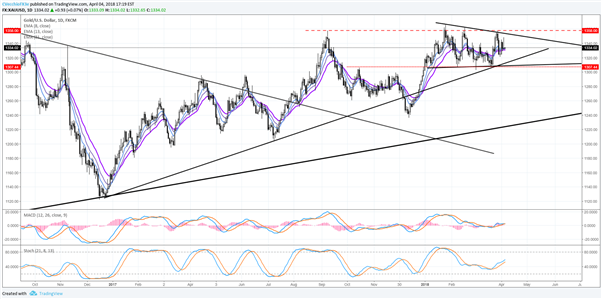Talking Points:
- Volatility in US equity markets and Gold[1] remains high, but has been hauntingly absent from FX markets. - Gold’s symmetrical triangle continues to eye a topside resolution. - Sentiment for the US Dollar[2] remains negative as the new quarter gets under way. For longer-term technical and fundamental analysis, and to view DailyFX analysts’ top trading ideas for 2018, check out the DailyFX Trading Guides[3] page. While trade war headlines continuing to drive equity market volatility, FX markets have been hauntingly quiet. On Wednesday, the S&P 500[4] closed nearly 85 handles above its low for the day, establishing a daily bullish outside engulfing bar in the process. Meanwhile, the DXY[5] Index barely registered a move at all, posting an inside day relative to Tuesday’s high-low range. For the US Dollar, there may be a legitimate case that the driver of equity market volatility – tension over trade tariffs with China – has proven to be an offsetting factor to the greenback’s current stature as a safe haven currency. We’ve previously discussed how a trade war is bad for the US economy, highlighting how the 2002 steel tariffs led to US Dollar weakness[6]. At the same time, we’ve also expressed how the US Dollar has embraced the role of a safe haven[7] currency once again: rising when equity markets are falling. These dueling factors have proven to be a road to nowhere for the US Dollar: while the imposition of tariffs and a trade war would be bad for the US Dollar, equity market weakness has driven demand for the safety of the world’s reserve currency. And vice-versa: when trade tensions ease, which are good for the US Dollar, they are allowing equity markets to rebound, which is negative for the buck. These factors are washing each other out. While we wait for FX markets – and similarly, bond markets – to partake in the large swings seen by stocks, a different safe haven has proven quite active amidst the headlines: Gold. Price Chart 1: Gold Daily Timeframe (September 2016 to April 2018) Gold remains in a consolidative, symmetrical triangle since the beginning of January. Price swings have been significant here as well, mirroring the moves in equity markets: as the S&P 500 roared back on Wednesday, Gold slid sharply from its daily highs back to its opening price level – more than a 1% drop intraday. Despite Gold’s inability in the short-term to break out of its symmetrical triangle yet, odds remain in favor of a topside break given both the fundamental and technical backdrop. Fundamentally, trade tensions have ratcheted higher across the globe thanks to the United States, be it with China, South Korea, Canada and
Gold remains in a consolidative, symmetrical triangle since the beginning of January. Price swings have been significant here as well, mirroring the moves in equity markets: as the S&P 500 roared back on Wednesday, Gold slid sharply from its daily highs back to its opening price level – more than a 1% drop intraday. Despite Gold’s inability in the short-term to break out of its symmetrical triangle yet, odds remain in favor of a topside break given both the fundamental and technical backdrop. Fundamentally, trade tensions have ratcheted higher across the globe thanks to the United States, be it with China, South Korea, Canada and



